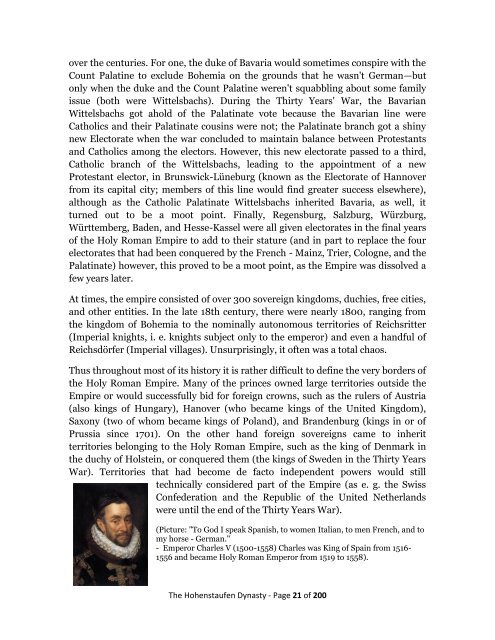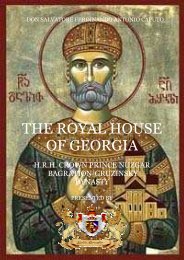here - Nobility Associations
here - Nobility Associations
here - Nobility Associations
Create successful ePaper yourself
Turn your PDF publications into a flip-book with our unique Google optimized e-Paper software.
over the centuries. For one, the duke of Bavaria would sometimes conspire with the<br />
Count Palatine to exclude Bohemia on the grounds that he wasn't German—but<br />
only when the duke and the Count Palatine weren't squabbling about some family<br />
issue (both were Wittelsbachs). During the Thirty Years' War, the Bavarian<br />
Wittelsbachs got ahold of the Palatinate vote because the Bavarian line were<br />
Catholics and their Palatinate cousins were not; the Palatinate branch got a shiny<br />
new Electorate when the war concluded to maintain balance between Protestants<br />
and Catholics among the electors. However, this new electorate passed to a third,<br />
Catholic branch of the Wittelsbachs, leading to the appointment of a new<br />
Protestant elector, in Brunswick-Lüneburg (known as the Electorate of Hannover<br />
from its capital city; members of this line would find greater success elsew<strong>here</strong>),<br />
although as the Catholic Palatinate Wittelsbachs inherited Bavaria, as well, it<br />
turned out to be a moot point. Finally, Regensburg, Salzburg, Würzburg,<br />
Württemberg, Baden, and Hesse-Kassel were all given electorates in the final years<br />
of the Holy Roman Empire to add to their stature (and in part to replace the four<br />
electorates that had been conquered by the French - Mainz, Trier, Cologne, and the<br />
Palatinate) however, this proved to be a moot point, as the Empire was dissolved a<br />
few years later.<br />
At times, the empire consisted of over 300 sovereign kingdoms, duchies, free cities,<br />
and other entities. In the late 18th century, t<strong>here</strong> were nearly 1800, ranging from<br />
the kingdom of Bohemia to the nominally autonomous territories of Reichsritter<br />
(Imperial knights, i. e. knights subject only to the emperor) and even a handful of<br />
Reichsdörfer (Imperial villages). Unsurprisingly, it often was a total chaos.<br />
Thus throughout most of its history it is rather difficult to define the very borders of<br />
the Holy Roman Empire. Many of the princes owned large territories outside the<br />
Empire or would successfully bid for foreign crowns, such as the rulers of Austria<br />
(also kings of Hungary), Hanover (who became kings of the United Kingdom),<br />
Saxony (two of whom became kings of Poland), and Brandenburg (kings in or of<br />
Prussia since 1701). On the other hand foreign sovereigns came to inherit<br />
territories belonging to the Holy Roman Empire, such as the king of Denmark in<br />
the duchy of Holstein, or conquered them (the kings of Sweden in the Thirty Years<br />
War). Territories that had become de facto independent powers would still<br />
technically considered part of the Empire (as e. g. the Swiss<br />
Confederation and the Republic of the United Netherlands<br />
were until the end of the Thirty Years War).<br />
(Picture: "To God I speak Spanish, to women Italian, to men French, and to<br />
my horse - German."<br />
- Emperor Charles V (1500-1558) Charles was King of Spain from 1516-<br />
1556 and became Holy Roman Emperor from 1519 to 1558).<br />
The Hohenstaufen Dynasty - Page 21 of 200



